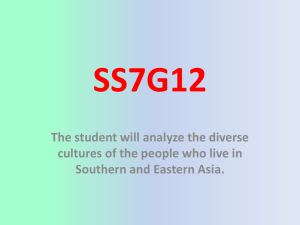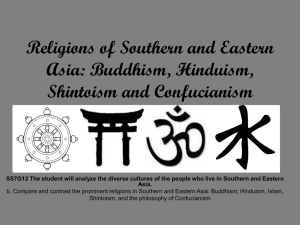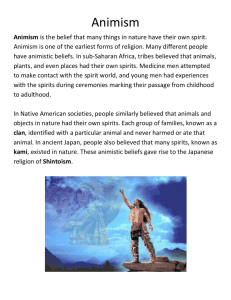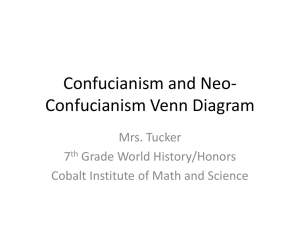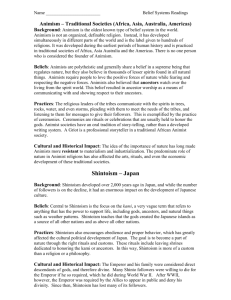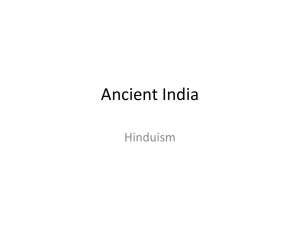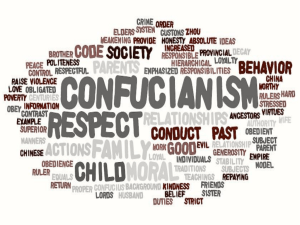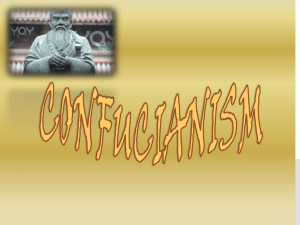Religions of Asia - Effingham County Schools
advertisement
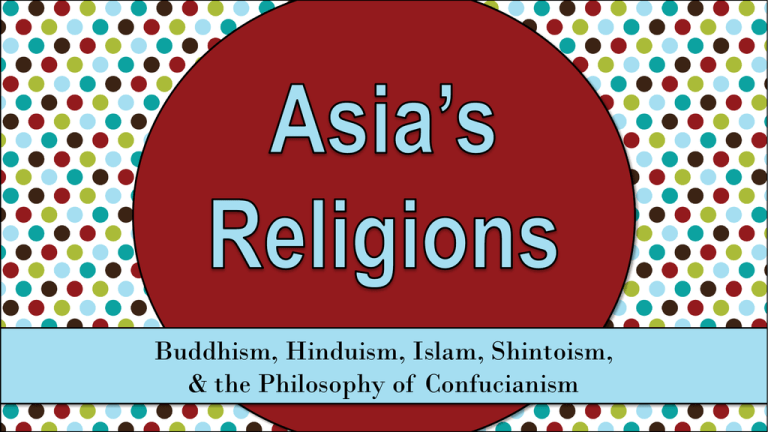
Buddhism, Hinduism, Islam, Shintoism, & the Philosophy of Confucianism Standards SS7G12 The student will analyze the diverse cultures of the people who live in Southern and Eastern Asia. a. Explain the differences between an ethnic group and a religious religious group. b. Compare and contrast the prominent religions in Southern and and Eastern Asia: Buddhism, Hinduism, Islam, Shintoism and the the philosophy of Confucianism. Buddhism, Hinduism, Islam, Shintoism, & the Philosophy of Confucianism • This is a group of people who share a common culture and have a similar language. • These characteristics have been part of their community for generations. • Ethnic groups can have many things in common: • Shared history, common ancestry, language, religion, traditions, beliefs, holidays, food, etc. • All of these things make up a common culture that is shared by the members of the ethnic group. • This is a group of people who share a common belief in a religious claim. • They believe in the same god (or gods) and have common sacred text with a specific set of rules about how to live. • Religious groups have many things in common: • God(s), prophets, prayers, history, sacred text, religious laws, holy days, etc. • A religious group can have members with different cultures, languages, and races and is usually spread over an entire region or many countries. • People from different ethnic groups may share the same religion; however, they may be from different cultures. • Buddhism originated in India around 500 BCE. • About 6% of the world’s population today is Buddhist. • Buddhism is the fourth largest religion in the world, though its largest numbers of followers are found in Southern and Eastern Asia. Distribution of Buddhists Around the World • Siddhartha Guatama was a rich man who led a life of luxury; however, he was troubled by the poverty and suffering that he saw around him. • He became a monk and traveled around India for years, hoping to find out why people had to suffer. • After meditating about the unhappiness of man, he finally thought he understood what had to be done. • He felt that people could find peace only if they could reject greed and desire. • He traveled all over India to share his enlightenment with others and he was called Buddha, or “The Enlightened One”. One of the earliest statues of Buddha – circa 1st-2nd century CE. Sarnath – where Buddha gave his first sermon. • Buddha taught that there were Four Noble Truths in life (basic instructions that teach suffering exists in the world and humans much reach enlightenment to rise above it). • Nirvana is the ultimate goal of Buddhists. • It is a state of enlightenment where one can have happiness and peace. • In order to achieve Nirvana, a person must follow The Middle Way (Eightfold Path – 8 rules for conduct). • Buddhists also believe in reincarnation, a cycle of birth and rebirth, where one’s behavior in this life determines what one becomes in the next life. 1. 2. 3. 4. 5. 6. 7. 8. Try to recognize the truth Try to avoid evil actions and bad people Do not say things that hurt others Respect other people and their belongings Choose a job that does no harm to others Do not think evil thoughts Avoid excitement or anger Work at meditation, thinking carefully about what matters in life • Buddha did not recognize gods because he felt man alone could change evil into good if he followed the Eightfold Path of the Middle Way. Painting of Buddha Surrounded By Monks Buddha Tooth Relic Temple - Singapore Mahabodhi temple in India - Where Buddha attained nirvana under the Bodhi tree. • The Buddhists’ holy book is called the Tripitaka. • It contains all of Buddha’s teachings. • Buddhists do not worship a god but rather Buddha by thanking him for his teachings and reading the Tripitaka to become more enlightened. Buddha Memorial Center - Taiwan • Hinduism developed in India around 1500 BCE. • It is one of the oldest religions in the world. • Today, Hinduism is largely practiced in India where over 80% of Indians claim to be Hindu. • Hinduism is the third largest religion in the world, behind Christianity and Islam. Akshardham Temple in Delhi – World’s Largest Hindu Temple • • Hinduism does not come from the teachings of one man. It is based on the religion practiced by the Aryans. • Aryan priests followed complicated prayers, rituals, and hymns known as The Vedas. • Today, there is not one single text that Hindus consider sacred, rather there are many like The Vedas that teach Hindus proper behavior. • Hinduism is polytheistic, meaning that Hindus worship many gods and goddesses. • Hindus believe that all living beings have souls (animals as well as people). • Some animals, like the cow, are especially sacred, and many Hindus are vegetarians. Diwali “Festival of Lights” – Hindu Celebration in India • All Hindus believe in reincarnation, the idea that the soul does not die with the body, but enters the body of another being (human or animal). • The type of life a person leads determines what the next life will be like. • A soul is reincarnated over and over again until it is good enough to achieve moksha (freedom from the cycle). • Hindus also believe that each person’s karma, or good or bad behavior, determines his fate. Statue of Shiva (Hindu Deity) – 65 Ft. Tall • Hindus live by the caste system (a belief that social class is hereditary and does not change throughout a person’s life). • The only way to change castes is to be born into a different one in the next life. • There are also divisions within each caste. • Traditional families would not let their children marry someone from another caste. • Many jobs in India are still awarded based on caste connections. • • The caste system divides people into 4 main classes: 1. Brahmans (priests and wise men) – highest class 2. Kashatriyas (warriors, rulers, soldiers) – next class 3. Vaishyas (merchants, traders, small farmers) – third 4. Shudras (peasants and field workers) – last class A fifth caste is considered even lower, the untouchables or pariahs, who do work that no one else would do. School of Untouchables – Early 1900s • Islam is usually known as the religion of the Middle East, but it is also widely practiced in Southern and Eastern Asia. • The largest Islamic nation in the world, Indonesia, is located here (204 million Muslims). • Islam began in the 7th century in the Arabian Peninsula. • Today, Islam is the second largest religion in the world and has spread worldwide. Islam by Country • Islam is based on the teachings of the prophet Muhammad. • Muslims consider him to be the greatest prophet of their God, Allah. • Muslims are monotheistic (believe in only one god). • They have a holy book called The Quran, which they believe is the word of Allah handed down by the angel Gabriel. • There are two types of Muslims: Sunni and Shi’ite. • They disagree on the basic teachings of Islam and are often in conflict with one another. Muslim Men Reciting The Quran in Indonesia. Jama Masjid - India’s Largest Mosque • 1. 2. 3. 4. 5. Muslims practice what is known as the Five Pillars of Islam, which are obligations that each Muslim must follow. Profession of faith – there is only one god and Muhammad is his messenger Pray five times a day facing the direction of Mecca (birthplace of Muhammad) Charity to the poor Fasting during the holy month of Ramadan Pilgrimage to Mecca at least once in a person’s lifetime The Kaaba, located in Mecca, is the center of Islam. • Shinto is the earliest religion in Japan. • It is unique to Japan and has not spread to other parts of the world. • Shinto means the “way of the gods”. • It was once the state religion of Japan and is still widely honored among the Japanese. • Shintoism has no rules for moral living and no concepts of a single ruling god. • There is no single text that is followed. • It centers on the reverence of the kami (divine spirits that live in nature). • Many Japanese believe that the mountains and rivers in Japan are home to these kami and are considered very sacred. Mt. Fuji – Sacred to Shintoism • Shintoists offer prayers and perform rituals to honor and please the kami. • Most Japanese households have a small altar where the family will offer prayers for the spirits they hope will bless and protect them. • Many worship their ancestors who they believe became kami when they died. • Shintoism stresses the virtue of cleanliness and teaches physical purity. • Since Shinto offers no ideas of a moral code, a god, or life after death, many people who practice Shinto also practice another religion as well. Torri gates mark the separation between the human world and the world of the kami. Torri Gates Outside of a Shinto Shrine Shinto Shrine The Philosophy of • Confucianism is not a religion but rather a philosophy that is often said to be the foundation of modern Chinese culture. • Confucianism was declared the official guiding practice for the Chinese government in 121 BCE. • It has continued to have great influence on Chinese government for over 2000 years. • Many people in China still support the teaching of Confucius and his emphasis on dealing with others fairly. • Confucianism is also practiced by others in East Asia. • Confucius was born in 550 BCE, a time when the government was having trouble keeping order and warlords controlled much of the land. • He believed he knew how to bring peace to ancient China – the key was for people to behave with good character and virtue. • Confucius created a moral structure for social life and politics that every person should follow. • Confucius was not a religious prophet or leader; he saw himself as a teacher. • Confucianism is thought of as a philosophy or ethical system based on good deeds and morality rather than a religion. • Confucius believed there were five basic relationships among men: ruler and subject, father and son, husband and wife, older brother and younger brother, & friend and friend. • He believed that if each relationship were based on kindness, there would be peace and harmony in the country. • His Golden Rule of Behavior was “What you do not like when done unto yourself, do not unto others.” Temple & Cemetery of Confucius in his Hometown • The Four Books and Five Classics are the authoritative books on Confucianism written before 300 BCE. • These are texts that illustrate the core value and belief systems in Confucianism. Credits: All photos were found via Creative Commons and labeled for reuse. • Fonts: • Backgrounds & Graphics: *The graphics used in this item are copyrighted and may not be used for your own commercial projects or given away to anyone else.
